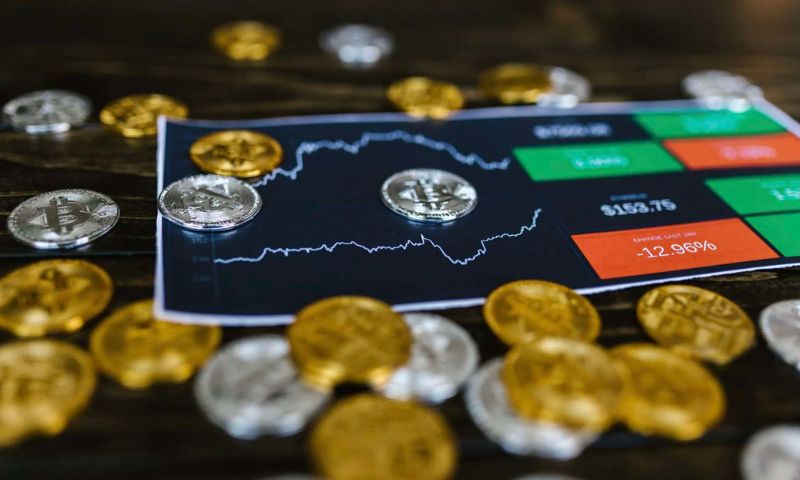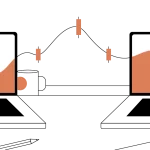Mastering how to use technical indicators for crypto is not just smart; it’s essential. With markets moving fast, you can’t afford to fall behind. Think of these tools as your secret map to buried treasure. They show you hidden paths and warn you of pitfalls ahead. In this guide, I’ll strip down complex charts to basics you can grasp in a flash. From the building blocks of analysis to skillful applications, you’ll learn to read market moods like a pro bookworm on speed-read mode. Trust me, once you get it, you’ll trade with the confidence of a captain steering through familiar seas. Let’s dive in and turn those intimidating squiggles into clear signals that shout “buy” or “sell.” Ready? Let’s chart your course to crypto conquest.
Understanding the Foundations of Cryptocurrency Technical Analysis
Demystifying Chart Patterns and Candlestick Formations
Let’s break down chart patterns first. Think of them like the footprints of market sentiment that, once recognized, can signal where the price might go next. Patterns come in many forms. There are ‘continuation’ patterns, that indicate a price move will keep going the way it has been. Bull flags and bear flags are popular ones. Then, there are ‘reversal’ patterns, suggesting a price change direction. Think head and shoulders or double tops.
Candlestick formations are another key concept. These are the building blocks of cryptocurrency chart analysis. Each candlestick holds data for a set time frame. It shows where price started and ended, and the high and low points in between. They give traders clues about momentum and future price moves. For example, a candlestick with a small body and long wick can signal a reversal. Spotting formations like the ‘hammer’ or ‘shooting star’ can really pay off.
Remember, no indicator can tell the future. They just help us guess what might come next. But with practice, we get better at these educated guesses.
The Role of Volume in Assessing Trade Opportunities
Now, let’s talk about trading volume. It’s a measure of how much of a cryptocurrency was traded in a given time. This can be an hour, a day, or more. Volume can tell us a lot about a coin’s health. A high volume move means more trust in that price change, whether it’s up or down. If a currency shoots up in price but volume is low, be wary. It could be a false signal.
Volume also helps to confirm trends. A steady upward price trend with high volume is a strong sign. It shows lots of folks are backing that upward push. The opposite is true for a downward trend.
When you pair volume with chart patterns, your cryptocurrency chart analysis gets more power. A big pattern breakout on high volume? That’s a strong buy signal. But if volume’s not there, think twice.
By understanding these basics of interpreting crypto charts, you’ll be on solid ground. You’ll start to see the art behind the science of trading. Technical analysis tools for digital currencies aren’t magic. They’re more like a compass, pointing you through the wilds of the market.
The more you study, the better your trading game will be. So dive into those cryptocurrency charts. Keep your eyes on patterns, candlestick formations, and volume. And stay sharp. Remember, in crypto trading, knowledge isn’t just power. It’s profit.
Integrating Core Technical Indicators into Your Strategy
Applying Bollinger Bands and MACD for Market Prediction
Do you want to guess less and win more in crypto trading? You need a solid plan! Bollinger Bands and MACD (Moving Average Convergence Divergence) are your best pals for predicting market moves. Let’s dig into how they work.
Bollinger Bands are like stretchy rulers for cryptocurrency chart analysis. They shape around prices on a chart. The bands get tight when big moves are coming. And when the price hits the band edges, it often swings the other way. This helps you guess where prices might go next.
MACD is like a pair of glasses that lets you see the market’s mood. It’s made of two moving lines on your chart. When the MACD line crosses over the signal line, it’s usually a sign that the market might go up. If it crosses under, the market could be heading down. It’s super for spotting trends early.
How RSI and Stochastic Oscillator Can Indicate Market Sentiment
Wondering if the market is too hot or too cold? The Relative Strength Index (RSI) and Stochastic Oscillator are your go-to tools. Here’s how they help:
RSI is a speedometer for market speed. A number between 0 and 100 tells you if crypto is sold too much (under 30) or bought too much (over 70). If it’s high, prices might drop. If it’s low, prices could rise. It’s awesome for figuring out the market vibe.
Stochastic Oscillator is like your friend who knows everything about ups and downs in the market. It compares where the crypto price is to its price range over time. When the Stochastic lines cross, it could mean a change in price is coming. It’s great for predicting turns in the market.
By blending these cool tools, you build a killer toolkit for interpreting crypto charts. Using Bollinger Bands, MACD, RSI, and Stochastic Oscillator together, you’ve got a strong lineup to make smart, quick calls in fast-moving crypto markets.
Remember, no single tool is perfect. They all have their moments. Mix and match to see what clicks for your crypto trades. With practice, your predictions will get sharper and your confidence will soar. Your crypto trading journey will always be evolving. Staying curious and open to learning is your key to success. Keep spotting those patterns, watching for signals, and you’ll lock in the wins over time.
Advancing Your Analysis with Sophisticated Techniques
Utilizing Fibonacci Retracement and Ichimoku Cloud for Deeper Insights
Trade like a pro by mastering two high-level tools. First up, Fibonacci retracement. It’s simple. It helps find where prices might turn or pause. Chart a high and low point; the tool shows levels between. These spots can be where price action takes a breather or flips direction.
Fibonacci is great with Bitcoin. Why? Because Bitcoin is king in crypto, its price moves shape the market. Watch for rebounds or drops near these levels. For Ethereum, it’s the same. Ethereum often follows Bitcoin’s steps, so use Fibonacci to find its key price zones.
Next, the Ichimoku Cloud. This one’s a powerhouse. It mixes past, present, and future data to show potential support or resistance areas. It’s like a weather forecast but for crypto prices. If the price sits above the cloud, things might keep climbing. Below the cloud can mean rain, or in our case, a potential drop.
This cloud also hints at price momentum. Quick-moving prices can punch through the cloud. Use it as a stop sign or a go signal. Ethereum traders, watch the cloud for a heads-up on trend shifts.
Ichimoku Cloud is a game changer for predicting moves. It’s not just lines; it’s insight into market spirits.
Differentiating Between Leading and Lagging Indicators
In trading, leading and lagging indicators are like your crypto crystal ball. Let’s crack how they differ. Leading indicators hint at future moves. They’re like scouts, running ahead to report back. RSI and Stochastic Oscillator fall into this camp. They pulse with the market’s heart, showing if crypto like Ether or Bitcoin is overbought or oversold.
Moving averages are often lagging. They follow by summing past prices and averaging them. They confirm trends, not predict. Think of them as history lessons that help you in the present. Lagging can be late to the party, but they still pack a punch.
Knowing when to use each is key. Use leading ones when you want a sneak peek. Grab lagging ones to confirm what you’re seeing. Together, they’re a tag team for your trades.
Champion traders use both to avoid false starts or exits. A mix of these helps you understand not just where the crypto market is, but also where it’s headed. And that, friends, is how we score in trading. Use these tools, and you’re not just trading; you’re translating the market’s secret code.
Practical Applications of Technical Analysis in Crypto Trading
Identifying Entry and Exit Points with Support and Resistance Levels
Trade well and you thrive in crypto markets. Ever tried to catch a wave? That’s like snagging the best trade points. Imagine the sea as the market and waves as price moves. Support is your surfboard’s rise, resistance its fall. You ride the rise, hop off before the fall.
Support levels feel like a floor where prices bounce up. Resistance, the ceiling, knocks prices down. Spot these in a chart and you’ve got your entry (buy) and exit (sell) spots. Think of it like a game plan where you call your shots.
Price dips to support? Get set to buy. Hits resistance? Be ready to sell. Eye these levels. They guide you to act smart, not on a whim. Use them right, say goodbye to panic buying or selling. Hello, solid strategy!
Trend lines add muscle to this strategy. They are like a map drawn on chart peaks and valleys. Follow them for a trail of where prices might jog next. Steer clear from emotional trades. Trust these lines. They’ve got your back.
Leveraging VWMA and OBV for Dynamic Trade Decisions
Now, let’s turn up the heat with VWMA and OBV indicators. VWMA, short for Volume Weighted Moving Average, is cool for spotting trends. It’s a moving average that values volume. High volume? The move is real. Trust it more.
The OBV, or On-Balance Volume, watches the flow of trade volume. It’s simple. Price jumps with volume lift are strong moves. They tell you the crowd agrees with the price hop. That’s a green light for action!
Combine VWMA with OBV, and you’re gold. When both scream ‘Go!’, dive in. They signal a firm move with the pack on your side. When they part ways, hold off. It’s a sign the market’s chatting, not yet shouting.
Start with these tools. They’re solid chums in the rough and tumble of crypto trade. They’re how you make sense of the wild runs and dips. They keep you steady, with less guesswork and more smart moves.
With these in hand, you’re set to read cryptocurrency chart analysis like a story. And as you get sharper at interpreting crypto charts, you win more. You get the why behind price dances. You see through the chaos.
Remember, tools are great, but your wit is king. Each trade’s a fresh game. No room for copy-paste. Test these tools. Learn them by heart. Soon, you’ll call out sweet spots in trading volume indicators in blockchain assets like you’re naming old friends.
Flex this know-how and you’re not just playing; you’re crafting victory in crypto markets. Stay curious, stay sharp, and watch your crypto prowess hit the roof!
To wrap it up, we broke down crypto technical analysis into easy bits. First, we looked at chart patterns and volume. They’re the bread and butter for spotting trade chances. Then we moved forward, adding Bollinger Bands, MACD, RSI, and the Stochastic Oscillator into our toolset. These help us predict market moves and feel its pulse.
We didn’t stop there. We explored Fibonacci and Ichimoku Cloud, giving us deeper insight. Knowing the difference between leading and lagging indicators boosted our edge. In the end, we got practical, using support and resistance to mark where to jump in or out of a trade, and tools like VWMA and OBV to make smart, dynamic decisions.
Remember, trading crypto using technical analysis is a craft. It blends science with a dash of art. With practice, we can sharpen our skills and trade with confidence. Keep studying, keep trading, and you’ll keep growing. Ready to use these strategies? Hit the markets, and let’s make some smart moves!
Q&A :
How do technical indicators help in trading cryptocurrencies?
Technical indicators are mathematical calculations based on the price, volume, or open interest of a cryptocurrency. They are used by traders to predict future market movements and identify potential trends or trading opportunities. By using various indicators, traders aim to gain insights into the strength, momentum, and direction of the crypto market, which can help in making informed trading decisions.
What are some popular technical indicators for analyzing crypto markets?
Several technical indicators are commonly used in the analysis of crypto markets. The Moving Average (MA), Relative Strength Index (RSI), and Moving Average Convergence Divergence (MACD) are among the popular ones. The MA helps smooth out price data to identify trends, RSI measures the speed and change of price movements indicating overbought or oversold conditions, and MACD shows the relationship between two moving averages of a crypto’s price.
Can technical indicators be used for long-term crypto investment strategies?
Yes, technical indicators can be incorporated into long-term crypto investment strategies. For instance, long-term investors may utilize Moving Averages like the 200-day MA to determine the overall market trend. When the price is above the 200-day MA, it’s generally considered a bullish trend, and when it’s below, a bearish trend. However, it’s important to remember that they should be used in conjunction with fundamental analysis and other factors for a comprehensive investment strategy.
How can I learn to apply technical indicators effectively in crypto trading?
To apply technical indicators effectively, you should begin by learning the basics of each indicator, understanding what it measures, and how it can be interpreted. You can find educational resources online, such as tutorials, webinars, or online courses. Practicing with a demo trading account is also useful to gain hands-on experience without risking real money. Lastly, keeping up with market news and joining trading communities for discussions can be beneficial.
Are there any risks associated with relying solely on technical indicators for crypto trading?
Yes, relying solely on technical indicators can be risky as they are not infallible. Technical indicators are based on past price data and may not always predict future movements accurately, especially in the highly volatile crypto market. Moreover, they don’t take into account fundamental factors like industry news, regulatory changes, or technological developments, which can have significant impacts on price. Diversifying your trading strategy to include a range of analysis methods can mitigate these risks.






